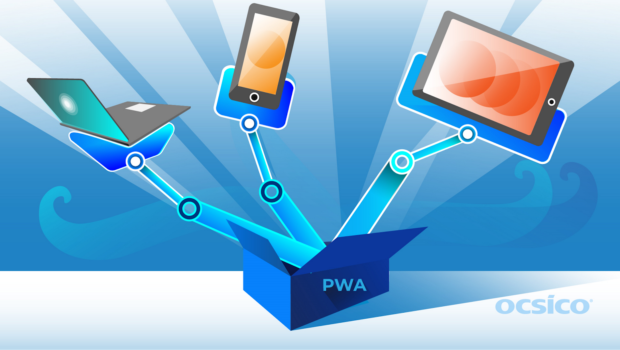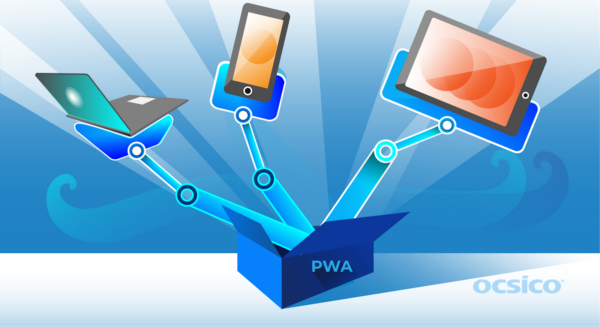Why You Need to Consider Developing a Progressive Web Application
A progressive web application (PWA) is a revolution in user experience. The technology is gaining popularity these days. It has already won many fans, like Twitter, Lancôme, Flipkart, Pinterest, etc., and it looks like PWAs are going to revamp our view of the web and mobile market.
What makes a PWA so special? In simple terms, it is a website with the functionality of a native mobile app. It has incorporated the best features of the web and native apps and has become their hybrid. No need to download, offline working mode, extremely easy to use, responsive to all kinds of screens – these are the advantages PWAs provide, to name a few.
The emergence of PWA was due to the multiple number of devices having access to the Internet. PCs, laptops, tablets and mobile phones – they all provide us with different user experience and require different types of software. This situation also causes the necessity for various versions of websites compatible with different screen sizes. Consequently, some companies simultaneously have a website, a mobile app, and a desktop application that adjusts to various devices and types of users. But now, companies can bet on PWA only, for in many cases it is capable of replacing those three.
What makes a PWA so special
1. Responsive UX-design
It’s one of the key advantages of this solution. A PWA can be easily accessed from any types of devices. The load time is the same, and the user experience is great no matter what you are using – a mobile phone or a laptop. The situation when a mobile version of a website looks much weaker than the original one is becoming a history thanks to PWA.
2. No need to download
Modern pace of life makes us praise the time. We expect everything done as quickly as possible. PWA is a champion when it comes to saving time. Have you ever felt impatience when waiting for the app to “migrate” from an app store to your mobile phone? The recent statistics show that one should be a real fan of a brand to download and install its native mobile application. With PWA you don’t have to spend precious time downloading whatever it is. Just click on the link and start using an app.
3. High load speed
If a website won’t load, how long will you be waiting for before passing on it? A couple of seconds, no more. In comparison with traditional mobile versions of websites, even if it’s the first time you’ve clicked on the link with an app, a PWA loads instantly. Some people even call it the fastest website in the world, though technically it’s not exactly a website. The teamwork of AMP’s web components and Service Workers ensures such high speed. Moreover, the PWA always stays up-to-the-minute. All the updates take place on the server, and the users don’t suffer from “heavy” updates overloading their devices.
4. Doesn’t take space on your device
Forget about the storage and manual updates issues. Reserve your device’s disk memory for the real memories, such as photos, videos, and so on and so on. A PWA is hosted on a server, and you don’t have to download it. If you take a look at some apps you install from an App Store or Google Play, you will find out that their size ranges from 38 to 200MB. Not to mention the regular updates that overload your device. PWAs, in their turn, are less than 1 MB and are automatically updated on a server. Precaching allows users to get the latest updates as soon as they open the PWA.
5. A piece of cake in terms of usage
You can install a PWA on a home screen for easy access. A user can start interacting with an app almost immediately without waiting for its download. Sharing is very simple as well. Just copy the app’s link and send it to whom it’s intended for. PWAs provide users with an engaging and so-called “app-like” experience. Push notifications keep users informed about events, sales, discounts, etc.
6. Can be used offline
A Service Worker is a technology that means a lot when it comes to PWAs. Simply put, it is a client-side proxy lying between a page and a server. The Service Worker enables the great offline experience, app’s fast loading, and the ability to send push notifications. When you load a PWA for the first time, the Service Worker is automatically installed, and the data are cached. That is why you don’t have to worry about the connection if you have used a particular PWA at least once. Even offline, it will be able to provide you with all the functionality. You may even not notice that the connection has dropped out.
7. Profit boosting for businesses
It’s a great opportunity for all kinds of brands to reach out to new customers and engage the loyal ones. You don’t have to decide on whether to download an app or not, you just click the link and that’s it. The fewer steps you do before starting your experience with a web solution, the fewer chances are left to drop it. The success of such giants as Tinder, Starbucks, and Pinterest shows that creating a PWA really makes sense. The best proof of this is a considerable rise in figures after a PWA launch. Users tend to spend much more time using a PWA compared to mobile websites that inevitably leads to the increase in conversions and number of purchases.
It all does sound perfect
So, shall we give up everything for a PWA? If you have a great mobile website, it’s better to thoroughly weigh all pros and cons before investing in rebuilding a solution that is already popular among consumers. If you are planning to start exploring the mobile world, creating a PWA is your justified choice. Anyway, it’s better to consult business web applications development specialists before making a final decision.
In spite of great advantages of the PWA, it is not almighty:
- The iOS browser doesn’t support all PWA features
- Some features typical for modern hardware, e.g., GPS or fingerprint scanners, are not supported by PWAs
- PWAs are browser-dependent
- PWAs do not support cross-application logins
- PWAs guarantee an “app-like” experience but still can’t fully reach the quality of mobile apps.
PWAs won’t displace native mobile apps in the nearest future
We’ve already realized that PWAs solve several issues related to familiar websites and native mobile apps usage. They have become a bridge between these two technologies, taking the best of both and smoothing disadvantages. Some of the leading world brands from various fields have recognized the power of the PWA. Progressive web applications provide users with a great user experience almost like the native mobile apps do. But on the other hand, the PWAs still can’t match the performance, quality, and persistence of the standard mobile solutions. Consequently, the complete abandoning of native mobile application development isn’t likely to happen at present and in the nearest future. But at the same time, one can’t deny the breakthrough in creating a great website user experience and the high potential of progressive web applications.
Author bio:
Helena Bogdanova is a Tech Journalist with OCSICO. She writes about IT, mobile applications, video games and more. You can contact Helena via [email protected].
















